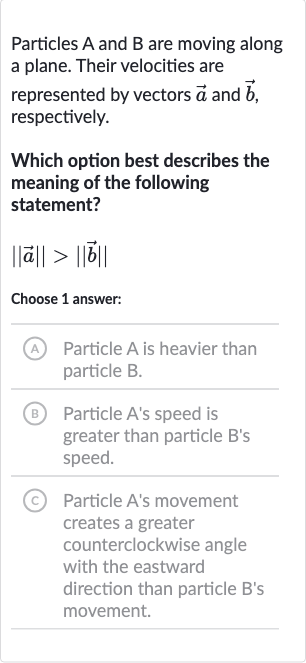AI tutor
Welcome to Bytelearn!
Let’s check out your problem:

Particles and are moving along a plane. Their velocities are represented by vectors and , respectively.Which option best describes the meaning of the following statement? \|\vec{a}\|>\|\vec{b}\| Choose answer:(A) Particle is heavier than particle .(B) Particle A's speed is greater than particle B's speed.(C) Particle A's movement creates a greater counterclockwise angle with the eastward direction than particle B's movement.
Full solution
Q. Particles and are moving along a plane. Their velocities are represented by vectors and , respectively.Which option best describes the meaning of the following statement?Choose answer:(A) Particle is heavier than particle .(B) Particle A's speed is greater than particle B's speed.(C) Particle A's movement creates a greater counterclockwise angle with the eastward direction than particle B's movement.
- Magnitude of Vectors: The statement || \vec{a}|| > || \vec{b}|| is comparing the magnitudes of two vectors, and . The magnitude of a vector represents the length of the vector, which in the context of velocity vectors, corresponds to the speed of the particle. Therefore, this statement is comparing the speeds of particles A and B.
- Interpretation of Option (A): Option (A) suggests that particle is heavier than particle . However, the statement given is about the magnitudes of velocity vectors and does not provide any information about the mass or weight of the particles. Therefore, option (A) is not the correct interpretation of the statement.
- Interpretation of Option (B): Option (B) states that particle A's speed is greater than particle B's speed. This interpretation is consistent with the meaning of the magnitudes of velocity vectors. Since represents the speed of particle A and represents the speed of particle B, the statement || \vec{a}|| > || \vec{b}|| indeed means that particle A's speed is greater than particle B's speed.
- Interpretation of Option (C): Option (C) suggests that particle 's movement creates a greater counterclockwise angle with the eastward direction than particle 's movement. The statement given does not provide any information about the direction of the velocities or their angles with respect to any direction. It only compares the magnitudes (speeds) of the velocities. Therefore, option (C) is not the correct interpretation of the statement.
More problems from Transformations of absolute value functions: translations and reflections
QuestionGet tutor help
QuestionGet tutor help
QuestionGet tutor help
QuestionGet tutor help
QuestionGet tutor help
QuestionGet tutor help
QuestionGet tutor help
QuestionGet tutor help
QuestionGet tutor help
